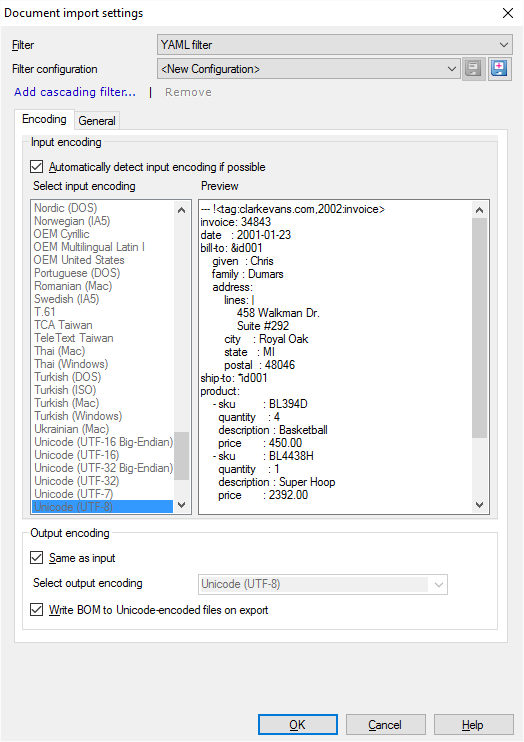YAML (YAML Ain't Markup Language) files
YAML is a Unicode based data serialization language. YAML stands for YAML Ain't Markup Language. YAML files use the set of printable Unicode characters (UTF-8, UTF-16 or UTF-32).
YAML is used for various purposes in programming. Examples: configuration files, Internet messaging, object persistence, data auditing. The YAML syntax was designed to correspond to data types (lists, associative arrays and scalars).
memoQ can import and export YAML files in versions 1.0, 1.1. and 1.2. YAML 1.2 is compliant with JSON.
To learn more about YAML: Visit this website (link avalable at the time of writing).
How to get here
- Start importing a YAML file.
- In the Document import options window, select the YAML files, and click Change filter and configuration.
- The Document import settings window appears. From the Filter drop-down list, choose YAML filter.

What can you do?
Normally, a YAML file is encoded in UTF-8.
But it can be encoded differently, and memoQ may not be able to recognize it. (Normally, memoQ tries to.)
Under Input encoding, check if the text in the Preview box is readable and if all characters are correct.
If the text isn't readable or not all characters are correct: From the Input encoding list, choose a different encoding. Try another encoding until the text in the Preview box is fully correct.
If the input encoding isn't Unicode (e.g. UTF-8), and the target language uses a different script: Clear the Same as input checkbox. Choose the encoding for the translated document from the Select output encoding drop-down box. To make it easier for other programs to recognize the encoding, you may want to select the Write BOM to Unicode-encoded files on export checkbox, too.
In a YAML file, a scalar block can have several lines of text.
Normally, memoQ imports every line of text as a separate segment.
To import every scalar block as one single segment: Click the same segment separated by memoQ tags radio button. When memoQ imports a multi-line block, you will have a memoQ {tag} for every newline character.
When you finish
To confirm the settings, and return to the Document import options window: Click OK.
To return the Document import options window, and not change the filter settings: Click Cancel.
In the Document import options window: Click OK again to start importing the documents.